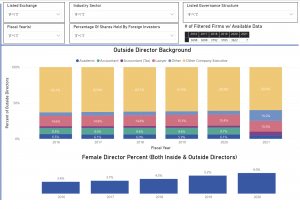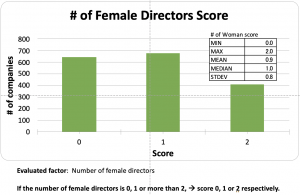
We have long considered the number of female directors as one of the key factors in board practices to measure how a company is willing to change, and according to the BDTI survey (3,622 companies as of March 26, 2021), the percentage of female directors on boards has improved significantly from 1.4% in 2016 but still only accounts for 6% of the total (see chart below).

Metrical’s survey of the universe companies, mainly those listed on the Tokyo Stock Exchange 1st section, also shows how few female directors there are (see chart below). Of the 1,729 listed companies in the universe, 643 (37.2% of all universe companies) have no female directors, 676 (39.1%) have one female director, and only 410 (23.7%) have two or more female directors.

State Street Global Advisors (SSGA) has now released its Guidelines for Voting and Engagement – Japan in the spotlight. In their guidelines, they state, “For companies comprising the TOPIX 500 Index, we expect at least one female director to be a member of the board of directors. If this expectation level is not met, we will vote against the chair of the nominating committee or, if the company does not have a nominating committee, the board leader, as appropriate.” As mentioned earlier, Metrical survey, 1,086 (62.8%) of the 1,729 listed companies in the universe have at least one female director on their board of directors, so I suspect that less than 20% of the large companies that make up the TOPIX500 index will actually vote against this issue. This is my guess. Numerous studies have shown that diversity contributes to the quality of the board of directors, increases the productivity of corporate activities, and contributes to value creation, and Metrical’s financial indicators of value creation have shown positive correlations of statistical significance with actual ROE and ROA in the past. Therefore, Metrical of course support SSGA’s voting and engagement guidelines. On the other hand, we regret that the recent revision of the Corporate Governance Code did not include a requirement for the recruitment of female directors.
Every year, the World Economic Forum (WEF) releases the Gender Gap Index, which quantifies the gender gap by country. Again this year, Japan scored significantly lower in the areas of economy and politics, ranking 117th in economy (115th in the previous year), 147th in politics (144th in the previous year), 92nd in education (91st in the previous year), and 65th in healthcare (40th in the previous year). As far as the economic sector is concerned, the survey points out that this is due to the low number of women in executive and managerial positions (14.7%), the fact that 50.8% of employed women are part-time workers compared to 22.2% of male workers, and that women’s income is 43.7% lower than men’s income. Thus, Japan is well known as a country where gender diversity is not advanced. In particular, since the COVID-19 pandemic, the distortion of the working environment due to gender has become a social problem, as a large percentage of women working in non-regular jobs and in industries directly affected by the pandemic, such as the restaurant, apparel, and tourism industries, have lost their jobs and faced economic challenges, and the percentage of female suicides has increased. Gender diversity can be said to be the first step toward board diversity. In a rapidly changing world, we cannot afford to allow diversity to remain stagnant forever, and it will have to change from the top of the organization and society. In this sense, it is clear that the role of diversity in contributing to the improvement of the quality of the board of directors is very significant.
